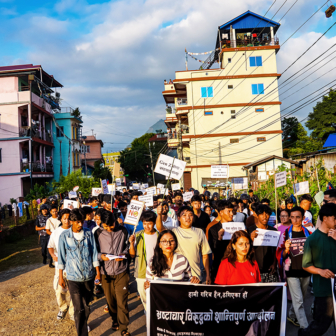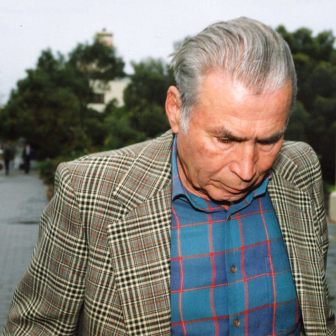Earlier this year a former judge inquiring into a much-discussed criminal case gave someone he trusted a preview of his findings. Within days, that preview was public knowledge and had prompted the government, before it could consider the judge’s report, to arrange a high-profile figure’s speedy exit.
None of this was controversial. The ex-judge was Tom Bathurst, most recently chief justice of New South Wales. His confidant was the state’s attorney-general, Michael Daley. And the high-profile figure was Kathleen Folbigg. Twenty years after being convicted of suffocating her four children, she was released from a Grafton prison.
Asked when Bathurst’s actual report would come out, Daley replied, “Without giving away any confidences, I think it would be appropriate to say that it will be weeks and not months.” The report was published last week, more than five months after Folbigg’s release.
Bathurst is the latest in a very lengthy string of judges who’ve ruled on Folbigg’s murder convictions. Six appeal judges, rejecting her first two appeals, all expressly said they agreed with the jury’s verdict. Three High Court judges (who had all once sat on the same appeals court) refused a further appeal, adding that the prosecution evidence was strong.
Just four years ago, in a different official inquiry, a former judge (previously head of a different New South Wales court) not only declared Folbigg guilty as charged but said that the further evidence he had heard “makes her guilt of these offences even more certain.” Two years ago, yet another appeal panel found ample basis for their former colleague’s ruling.
That’s twelve judges and one former one who’ve ruled Folbigg’s conviction safe, with no dissenters or doubters. Until now.
As he foreshadowed to Daley, Bathurst has told the state governor (a former head of the appeals court who had already pardoned Folbigg) that “there is reasonable doubt as to Ms Folbigg’s guilt” of each of her alleged crimes.
What created the doubt, according to Bathurst’s report, was new evidence that emerged just as the previous inquiry reported. Rather than supporting the finding that Kathleen Folbigg smothered her children, it showed that her two daughters shared a gene that could kill them. Other new evidence firmed up the likelihood that one of her son’s multiple afflictions also had natural causes. Bathurst accepted most, but not all, of this expert evidence.
Also presented was fresh psychological evidence about how to read diaries written by people under stress. Folbigg had written, for instance, of her husband’s “morbid fear” of their fourth child dying, “Well I know there’s nothing wrong with her. Nothing out of ordinary any way. Because it was me not them,” adding “I’ve learnt once it’s getting to me to walk away… With Sarah [her third child] all I wanted was her to shut up. And one day she did.” Bathurst said that these, and similar entries, were “evidence of self-blame” and concluded that the diaries contained no “reliable admissions of guilt.”
But it’s not only evidence that changes with time. As academic Emma Cunliffe details in her masterwork on Folbigg’s case, shared assumptions about multiple infant deaths have shifted with the decades. Once, those deaths were attributed to sleep apnoea, but then New York police investigated a family whose experience had been presented as key evidence of that theory and came away with the mother’s confession to five infant murders. Unsurprisingly, maternal suffocation became the preferred go-to, until the doctor who coined the term “Munchausen syndrome by proxy” was disgraced for giving bad statistical evidence in homicide trials. Folbigg’s misfortune was to be tried just before genes’ and trauma’s stars rose as explanation for such family tragedies.
Another change is simply that Folbigg’s trial is now much less recent. As anger, shock and memories recede and anticipated confirmations — confessions, revelations, similar cases — fail to materialise, space opens up for murderers to be unmade in the public’s mind. (Folbigg has long had champions including, startlingly, Alan Jones.)
Given the myriad possible explanations for the late turnabout in Folbigg’s case, I’m content to put aside the less palatable ones — medical fashion, malleable opinion, multiple wrong judges or jurors, or error on the part of Bathurst himself — and pin it all on the fresh evidence.
But there’s a further uncomfortable fact that Bathurst, Daley and others never mention, and that I’m not content to let slide: Kathleen Folbigg was unfairly tried in 2003, something New South Wales’s judges have known perfectly well for at least seventeen years.
Kathleen Folbigg’s two-month trial nearly collapsed in its second week. The trouble started when a new lawyer named Annabel dropped by to watch the proceedings and immediately recognised one of the jurors. She phoned a friend to confirm that her boyfriend was on the panel and then asked, “Did you know that was the case I was working on?” Annabel had done her student training at legal aid and had helped to prepare Folbigg’s defence.
It belatedly dawned on her that her phone call may have worsened the situation. Still worse, her friend had been part of her uni study group and may have been there when she described her work on the case. Worst of all, she might have told the group her personal view: that Folbigg was guilty as charged but shouldn’t be jailed. She promptly told the trial lawyers everything.
Folbigg’s prosecutor was dismissive — jurors often hear others’ takes in high-profile cases — but the defence fretted that Annabel’s opinions may be given particular weight. The judge, loathe to act on mere possibilities, opted to put the juror on the stand. He testified that he knew Annabel and about her phone call to his girlfriend, but, asked whether he had heard any of the lawyer’s opinions about the case, replied, “None whatsoever.” He was returned to the jury room with instructions to discuss the case with no one, including his girlfriend.
Justice Graham Barr made many decisions in 2003 that have aged well. Crucially, he barred all of the medical experts from opining on the likelihood of four natural infant deaths in a single family, restricting them to discussing each child individually. Bathurst ruled that Barr’s take matched the state-of-the-art medical thinking two decades later, and disclaimed the stance of then prosecutor Mark Tedeschi, who likened the defence case to a person being “hit by lightning four times.”
Tedeschi repeatedly tried to inform the jury of another startling fact about Kathleen Folbigg: that her father had killed her mother. The prosecutor initially said that it “provided an explanation for why the accused may have smothered her children.” Later, he claimed that it explained how Folbigg’s self-description in her diary as “my father’s daughter” amounted to a confession to the murders. Finally, he argued that the jury needed to know the history to understand her discussions about it with her husband and, later, the police.
Barr knocked back each of these attempts in turn, explaining that “the risk of misuse of the evidence is so great that I doubt whether any direction can obviate it.” This year, Folbigg’s ex-husband Craig complained that her troubled childhood was scarcely mentioned in Bathurst’s inquiry. He urged that it should be put in the report to the governor as evidence of his former wife’s possible inherited traits, mental illness and consciousness of guilt. Bathurst’s report dismissed this “rank speculation,” instead listing Craig’s unreliable trial testimony as a further reason to doubt the jury’s verdict.
It is a tribute to Barr that the courts have identified only one mistake he made: giving Folbigg too harsh a sentence. On the morning of 17 February 2005, the first three judges to review her case upheld her conviction but lowered her sentence from Barr’s forty years to thirty, leaving her eligible for parole in 2028. “Any person who was properly informed, sensible and thoughtful” would see how her “tragic background” — which effectively left her an orphan — “explains to some extent, although it does not excuse to any extent, how the crimes came to be committed.”
Barr’s excellent judging was something of a misfortune for Folbigg. A fair trial means a fair verdict. Or so it seemed that morning. That afternoon, Annabel emailed legal aid with some bad news about Folbigg’s jury.
Two brief court judgements are the only public insight into the flurry of behind-the-scenes events kicked off by Annabel’s email from early 2005 to late 2007. Even the judgements that emerged are unusual, because courts typically cannot rule on evidence that emerges after (here, hours after) a convicted offender loses her first appeal. Bizarrely, a missing staple on her court file allowed an exception in Folbigg’s case.
Thanks to the missing staple, we know that Annabel’s email recounted how a juror she “knew” had told her that “one of the jurors had researched Kathy’s history etc on the internet” during the trial. A year-long court-ordered investigation followed. Thanks to the rules protecting jurors and their deliberations, the only public outcomes of that investigation are terse summaries of “two instances of potential irregularity in the conduct of the jury trial.”
One involved the fact that some of the infants’ bodies were warm when paramedics arrived. The jurors were curious about how long bodies stay warm, and one asked a nurse friend. Such inquiries are forbidden, but the court ruled that, luckily, what the jury was told — that bodies stay warm for quite a while — helped the defence.
The other irregularity was far more serious. A juror googled “Kathleen Folbigg,” read “several related sites” and told others what they said: that Folbigg’s father killed her mother when Folbigg was an infant. This discussion happened early in the trial, while Tedeschi tried and Barr refused to let the jurors know this very fact, blissfully unaware that their debate was moot.
The jury verdict would also be moot unless the court was “satisfied” that what the jury discovered had not affected their verdict. And here’s where the story took another turn.
Chief judge Peter McClellan explained the appeals judges’ take in a single paragraph:
Even though the appellant was the child of a person who killed another I do not believe there was any likelihood that a juror would reason that it was more likely that the appellant would kill her own children. The killing of a spouse may tragically occur in circumstances of the breakdown of a relationship or be occasioned by temporary loss of control accompanied by a violent and fatal act. The circumstances and motive for the killing are likely to be quite different from those which will exist if a mother has killed her own children. There could be no suggestion that the killing of the appellant’s mother by her father indicated any tendency in the appellant to kill her own children. In my judgment the knowledge obtained by the juror did not lead to a miscarriage of justice.
Judges Carolyn Simpson and soon-to-be-High-Court-justice Virginia Bell agreed without comment. The panel, satisfied that the juror’s research hadn’t affected the jury’s verdict, dismissed Folbigg’s second appeal and caused her to spend sixteen more years in prison.
There is no nice way to say this: what the court says here is wrong. It’s possible that the sheriff’s investigation turned up a quite different reason to be satisfied that the jury’s verdict was unaffected by the learning about Folbigg’s childhood, but the reason the court gave — that the jury would have simply shrugged and ignored it — is ridiculous.
Don’t just take my word for it. Take the word of prosecutor Mark Tedeschi, who argued that the jury could use the information to apply “the attachment theory, which is that children who have gone through the sort of early life that this accused went through may have difficulty themselves bonding with their own children.” Or trial judge Graham Barr, who acknowledged that the family history had “substantial” value in interpreting Folbigg’s diary, but that that still did not outweigh “the danger of unfair prejudice.”
Or why not appeal judge Peter McClellan? A decade after ruling on Folbigg, he headed the royal commission into institutional child abuse. There, he wrote eloquently about how “adverse childhood experiences can negatively influence a person’s emotional, social and cognitive development.” But he also bemoaned the “misconception… that victims of child sexual abuse go on to sexually offend against children themselves,” a conception sadly voiced by some victims when they privately confessed their own crimes to the commission.
My point, of course, isn’t that Folbigg’s history casts light on her guilt or innocence. Rather, it’s the possibility that one or more jurors may have seen such a link themselves, much as her ex-husband and others did. Or, as Barr feared, that one or more of them might have somehow irrationally judged her for her father’s crimes. I struggle to imagine why the appeal judges couldn’t imagine these possibilities.
Indeed, I have a further, more speculative worry, based on what Folbigg wrote in her diary between the death of her third child and the conception of her fourth:
I’m ready to continue my family time now. Obviously, I’m my father’s daughter. But I think losing my temper stage and being frustrated with everything has passed.
Craig Folbigg, the police and Tedeschi all thought the middle sentence was a confession to a homicidal temper. Barr ordered that it be whited out in the jury’s copy of the diary, and belatedly told Tedeschi not to mention the word “But” either.
But I fear that the jury could well have puzzled out what was behind the white-out, for two reasons. First, Craig Folbigg himself blurted the hidden sentence from the diary to the jury in the trial’s first week, the same period when one juror turned to Google. And, second, they were highlighted in pretrial articles about the case, ones that also reveal the history that juror found via Google. This makes it possible that Folbigg’s jurors in 2003 may have mimicked the very moment in 1999 when Craig Folbigg says that he started to think his wife was a murderer.
Fortunately, there’s no need to dwell on whether Folbigg’s seventh, eighth and ninth judges were wrong, any more than whether the other ten were wrong. Nor is there any need to engage in some undoubtedly uncomfortable speculation about why. Instead, as of this week, we can let all of that slide.
Just as evidence, and our takes on it or particular cases shift with time, so do courts’ takes on what is, and isn’t, a fair trial.
Juror research was once a matter of jokes, shrugs and warnings, but now it’s a crime in most parts of Australia. And, just this week, Australia’s High Court ruled that the past approach of the NSW courts to juror misconduct, including the test applied to dismiss Folbigg’s appeal, was wrong. Rather, when jurors knowingly disobey a judge’s direction, other than a trivial one, it will always be a miscarriage of justice.
The case before the High Court, like Folbigg’s, involved the discovery, after a trial, that one juror had searched the internet early in the case and had told the others what he found. The majority’s new test in such cases is to ask whether a layperson might reasonably apprehend that any juror might, as a consequence, not have decided the accused’s guilt on the evidence, according to law. If so, the majority declared, the trial would be “incurably flawed.”
The majority went on to rule that the new test wasn’t met in the case before it, but only because the juror had searched for information about how crimes are sentenced rather than about the accused or the case or the rules of proof. That was still wrong, they said, but it simply wasn’t clear either way whether the juror (and the other jurors, who didn’t report him during the trial) realised it was wrong.
Last year, I said much the same about the juror who brought an academic article about false rape accusations into a jury room, perhaps in the belief that such general research was allowed. Cases like these sharply contrast with what Folbigg’s juror did, specifically googling her name, reading websites about her case, and telling other jurors what was there. There is no way that could pass muster after this week.
Again, you don’t have to take my word for it. The other two judges in the High Court case, James Edelman and Simon Steward, who would have sent the case before them to a lower court for a rethink, decided to illustrate why the previous New South Wales approach was so dangerous. The example they chose was Folbigg’s appeal, during which, they said, the appeal panel “applied the wrong test,” “placed itself in the position of the jury” and “effectively reversed the usual onus.”
This step — effectively becoming the fifteenth and sixteenth judges to weigh in on Folbigg’s convictions — is extraordinary. It is also, surely, no coincidence that it comes after Bathurst’s report, which should be prompting many Australian judges to wonder what went wrong in that particular prosecution.
This week, three more NSW judges — the seventeenth through nineteenth, by my count — will be asked to weigh in on Folbigg’s conviction. Although Folbigg is out of jail (and cannot go back), she remains a convicted child murderer, unless and until a court holds otherwise.
Bathurst referred Folbigg’s case back to his former court so they could explore the same issue he’d decided: whether or not there is reasonable doubt about her conviction. But there is no need for the new court to, yet again, weigh up all of the evidence for or against.
The new judges can, and should, simply quash her jury’s verdicts because her trial was unfair, as their predecessors should have done sixteen years ago. •




